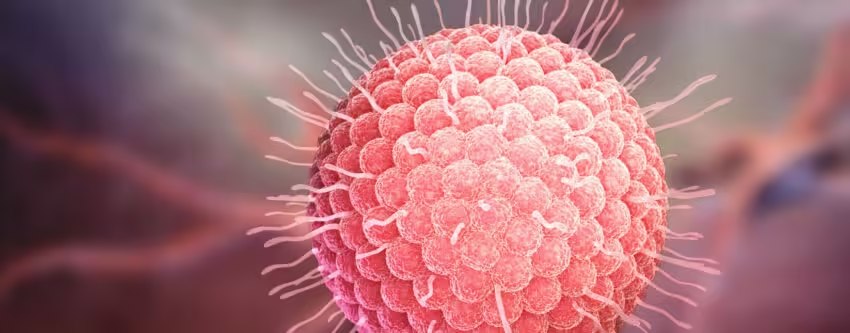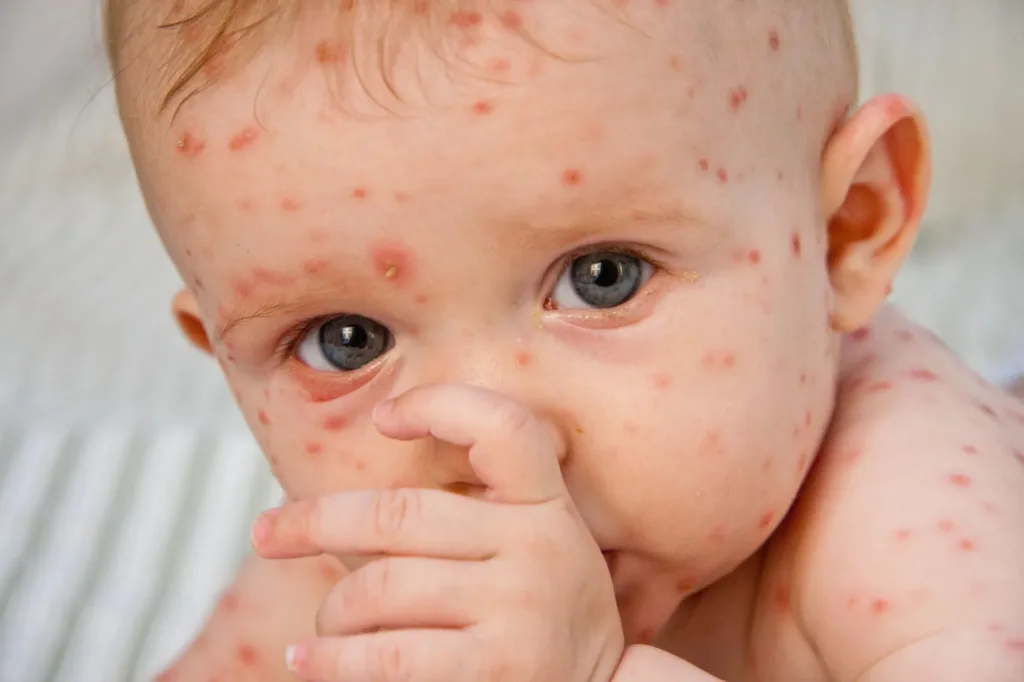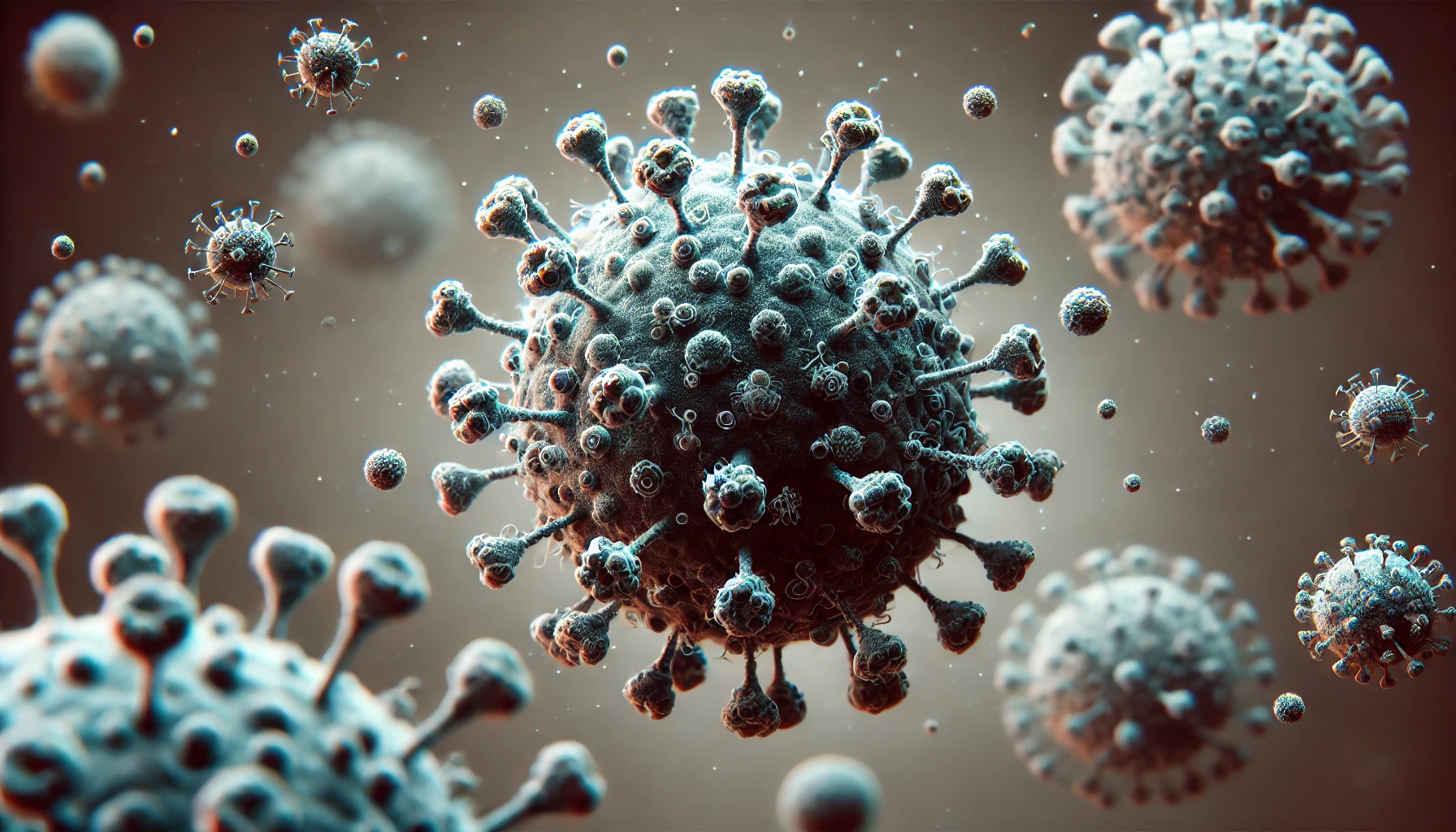Definition of Chickenpox
Chickenpox (Varicella) is a highly contagious infectious disease with the potential to cause large-scale epidemics. The primary clinical manifestation is a vesicular rash on the skin and mucous membranes. In most cases, the disease has a benign course; however, it can occasionally be fatal, particularly in immunocompromised individuals, due to severe complications such as varicella pneumonia and encephalitis.
Etiology
The Varicella-zoster virus (VZV) is the causative agent of chickenpox and herpes zoster (shingles). Chickenpox typically occurs in individuals who have not yet developed immunity to VZV, whereas herpes zoster represents the reactivation of a latent infection.

People primarily transmit chickenpox directly to one another via respiratory droplets, with fewer cases resulting from direct contact with vesicular fluid. Additionally, airborne transmission occurs, particularly during outbreaks.
Symptoms of Chickenpox
The disease progresses through four stages:
Incubation period
This period is defined as the time from exposure to the Varicella-zoster virus (VZV) until the onset of the first symptoms, ranging from 10-20 days, with an average of 14-15 days.
Prodromal period
- Fever: Mild fever, sometimes accompanied by chills or occasionally high fever. High fever reflects severe toxemia, often seen in immunocompromised patients. Associated symptoms may include fatigue, loss of appetite, headache, and sometimes mild abdominal pain.
- Rash: Some patients develop a rash, a precursor to vesicles. These are erythematous macules that appear on normal skin, a few millimeters in size. They typically last for 24 hours before becoming vesicles. Additionally, the patient may experience itching.

Eruptive stage
Also known as the vesicular stage. This stage’s key and characteristic symptom is the vesicular rash on the skin and mucous membranes.
Patients often experience a reduction in fever or remain afebrile; however, immunocompromised patients may continue to have high fever due to toxemia.
At this stage, round or teardrop-shaped vesicles appear on a pinkish base, most commonly less than 5 mm in diameter. The vesicles initially contain clear fluid, which becomes cloudy after 24 hours. The rash begins on the trunk and then spreads to the face and extremities. Different stages of the vesicles can be seen on the same skin area: macules, clear vesicles, cloudy vesicles, crusts from ruptured vesicles, and occasionally hemorrhagic vesicles.
Vesicles may also appear on mucous membranes, such as the oral mucosa, gastrointestinal tract, respiratory tract, and urinary tract, leading to symptoms in these organs, such as painful swallowing, vomiting, abdominal pain, diarrhea, coughing, shortness of breath, dysuria, and hematuria. Moreover, vesicles can also occur on the vaginal mucosa and conjunctiva.
The patient may experience itching and lymphadenopathy. If superinfection occurs, the lymph nodes may become swollen and painful.
The severity of the disease is related to the number of vesicles: the more vesicles, the more severe the disease. Younger children usually have milder disease compared to older children; however, in adults, the mortality rate from chickenpox is 15 times higher than in children.
Special populations, such as immunocompromised patients and pregnant women with chickenpox, tend to have more severe symptoms and are more prone to complications such as pneumonia, encephalitis, and fetal harm.
Recovery period
After about a week, most vesicles crust over, and the patient enters recovery. In individuals with normal health, the vesicles do not leave scars. Superinfected vesicles may leave small scars.
Complications of chickenpox
Chickenpox is generally a benign disease, except in immunocompromised patients. In individuals with normal health, complications are rare, except for superinfection. Some complications of chickenpox include:
- Superinfection: The most common complication of chickenpox is usually caused by the patient scratching and breaking the vesicles due to itching. The most common bacteria causing superinfection are Streptococcus pyogenes and Staphylococcus aureus. Symptoms of superinfection include high fever, chills, and vesicles becoming purulent and painful. Moreover, extensive superinfection can lead to sepsis.
- Varicella pneumonia: The most severe complication of chickenpox, more common in adults and immunocompromised patients than in children, especially pregnant women. The complication typically occurs on days 3-5 of the disease, with common symptoms such as high fever, cough, shortness of breath, rapid breathing, and chest pain. Additionally, hemoptysis and cyanosis may occur. The disease course is highly variable. Early treatment with Acyclovir and respiratory support can quickly improve dyspnea and fever.
- Encephalitis: The most common neurological complication, potentially fatal in adults. Common symptoms include high fever, altered consciousness, ataxia, nystagmus, and chorea. Additionally, seizures and coma may occur. Other complications include meningitis, transverse myelitis, and peripheral neuropathy.
- Reye’s syndrome: A hepatocerebral disease occurring in the vesicular stage if a child takes aspirin to reduce fever and pain. Common symptoms include anxiety, restlessness, and irritability; in addition, coma, and seizures due to cerebral edema. Furthermore, jaundice, hepatomegaly, and visceral hemorrhage may occur.
- Chickenpox in immunocompromised patients: In immunocompromised patients, such as those with lymphoma, bone marrow transplants, or HIV/AIDS, chickenpox is more severe, with more complications and a prolonged recovery period.
- Hepatitis in chickenpox patients: Usually presents with few clinical symptoms, and diagnosis is primarily based on elevated liver enzymes in tests. Symptoms suggesting hepatitis include frequent vomiting, commonly seen in immunocompromised patients.
Diagnosis
The diagnosis of chickenpox is primarily based on clinical presentation and does not usually require confirmatory testing. The characteristic chickenpox rash, with vesicles of varying stages scattered across the body in a patient with a history of contact with someone who has chickenpox, suggests the diagnosis.

Confirmatory tests for chickenpox are not readily available in clinical practice and are rarely used; these include:
- Vesicle fluid examination: Tzanck smear to identify multinucleated giant cells, PCR to detect Herpes zoster DNA.
- Serological testing: To detect seroconversion or increased antibody titers against Herpes zoster.
Differential diagnosis
Chickenpox should be differentiated from other vesicular rash illnesses such as hand, foot, and mouth disease caused by Enterovirus, Herpes simplex infections, impetigo, and other conditions.
Hand, foot, and mouth disease caused by Enterovirus also presents with vesicular rashes, including those on mucous membranes (mouth, throat) similar to chickenpox. However, the rash in hand, foot, and mouth disease is typically smaller and concentrated on the hands, feet, and buttocks, involving the palms and soles.
Rashes caused by Herpes simplex usually appear in clusters on the mucocutaneous junctions around natural orifices and, unlike chickenpox, do not spread over the entire body.
Treatment
Symptomatic treatment
- Pain relief and fever reduction with Paracetamol
- Itch relief with antihistamines
Prevention and treatment of superinfection
- Skin hygiene is paramount; regular bathing with soap and application of methylene blue
- Use of antibiotics if superinfection occurs
Treatment of complications, if present
- Reye’s syndrome
- Varicella pneumonia
- Varicella encephalitis
Besides antiviral drugs, supportive care is the mainstay of treatment
Antiviral therapy
- Antiviral drugs help shorten the duration of illness, limit complications, and reduce skin damage. They are most effective if used within 24 hours of rash onset.
- Commonly used drugs: Acyclovir, Valacyclovir, Famciclovir
Management and isolation of the patient
Chickenpox is one of nine group B infectious diseases that require medical isolation. Patients should be treated as outpatients and isolated at home in uncomplicated cases. Severe cases require hospitalization and isolation.
Isolation can be discontinued when vesicles have crusted over, typically after one week from onset, to prevent the spread of the disease.
Some studies suggest that patients with herpes zoster should be isolated similarly to those with chickenpox.
Prevention
General Prevention
Achieving high efficacy is challenging because the disease can be contagious 24-48 hours before vesicles appear.
Avoid close contact with individuals with chickenpox, especially contact with fluids from the rash vesicles.
Wear a mask in public or crowded places.
Vaccination
- Passive immunization: Immunoglobulin can protect or mitigate the severity of the disease in high-risk individuals, particularly immunocompromised patients and pregnant women.
- Active immunization: Vaccination with live attenuated varicella vaccine. Post-vaccination immunity is achieved in 94-100% of cases and is long-lasting.
- Antiviral prophylaxis: Antiviral drugs can be used for prevention in high-risk individuals who are contraindicated for vaccination. Commonly used drugs include Acyclovir, Valacyclovir, and Famciclovir for a duration of 7 days.

